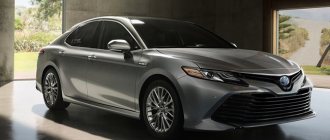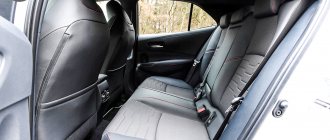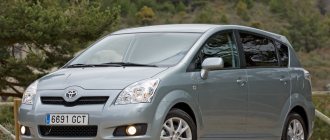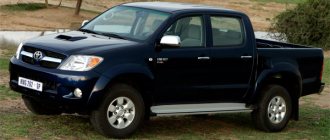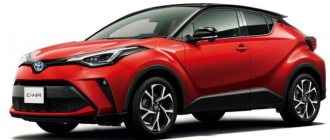Toyota Corolla Verso: Japanese Scenic
Formally, the Japanese were the first - compact single-volume cars appeared with them back in the early 80s. But then for some reason it did not create any sensation: after being present in the range for several years, they quietly disappeared... But when the Renault Scenic appeared, received the title “Car of the Year” and became an icon of the class for many years to come, the Japanese for some reason thought for a very long time . We thought and thought and came up with the Toyota Corolla Verso.
As a matter of fact, the Scenic became an icon of its class not only because it appeared first, but also because it offered “everything at once”: “passenger-like” driving performance, spaciousness amazing for its size, and a multifunctional interior... It’s not surprising that the creators of the Toyota Corolla Verso largely copied the “Frenchman”. And of course, we couldn’t resist “improving” the idea in places.
You are unlikely to remember the interior design, except perhaps for the unusual turquoise lighting. Otherwise, it's a typical Toyota, comfortable, well put together, but doesn't stand out at all. The driving position, despite the adjustments, still remains a bit high, but otherwise the ergonomics are good: the gearbox is “at hand,” visibility is good, and the seat itself is quite comfortable. Again, the interior pleases with its “wear resistance” - this car is manufactured in 2008. no abrasions, rattling, etc. were noticed. If only Touran could do that...
The middle row is made in the traditional manner for this class: three separate seats with adjustable backrest angles and the ability to move back and forth. The main advantage compared to the same Scenic is the seats themselves. They have a higher back, are more comfortable and sit slightly higher off the floor, making the fit more natural. Well, a decent amount of space in the cabin should also be noted.
There are also third-row seats in the Corolla Verso - they fold flush with the trunk floor and take up minimal space when folded. Unfortunately, we were unable to verify this: the car provided turned out to be a 5-seater version. And therefore, instead of the third row, there is only an “organizer” under the false trunk floor.
The trunk itself, as befits a family-oriented car, is huge and comfortable. The backs of the rear seats alternately fold flush with the floor, which gives enormous possibilities for transforming the interior: you can transport both long items and passengers at the same time, or you can fold everything and “throw in”, for example, a refrigerator.
1.6 liters? Isn't that enough? No! Firstly, this is a Toyota “VTEK” - an engine with variable valve timing, which makes it elastic and “torque”, and secondly, a family car doesn’t need anything else! Does it start easily? Easily. Does it accelerate normally? Fine. Are there any problems with tight driving? No. So, you can take it. Personally, I have no complaints about the dynamics of this particular version - it’s quite a convenient option.
There are no questions about handling either. Yes, it’s not a “light”, but it drives very decently: the rolls are small and the chassis is “correct”. Again, unlike the regular Corolla, the suspension seems softer, not so sensitive to “small things”. And this, in general, fits perfectly into the concept of a family car: a small but spacious, moderately dynamic, but quite comfortable and pleasant to drive car. Pavel KOZLOVSKY ABW.BY Who is against?
— I need a spacious car with the ability to transform the interior: to transport large cargo and pick up my mother-in-law from the dacha. I want easy handling, “minivan” capacity and high reliability, so that the money saved does not go to repairing the “engine”, but is spent on vacation... “The Toyota Corolla Verso compact van will suit you,” many car enthusiasts will say, and I agree, but only partly.
My colleague has already appreciated both the possibilities of transforming the interior and the nuances of handling - here I completely agree with him. But in terms of the reliability of the Corolla Verso, I would first of all recommend not to blindly believe the prevailing myth about Toyota products, but to take a sober approach to choosing a family car. Let's start in ascending order. Firstly, even when heavily used, the Toyota Corolla Verso lacks owners in small things: the electrical equipment works without “glitches”, plastic panels in the cabin do not fall off. Is it possible to remember a characteristic problem of many Verso - failure of the rear windshield wiper: as a rule, this is either a collapsed gear or a burnt out circuit board. Informed owners have long learned to “cure” the malfunction, since replacing the unit assembly can cost $300. Secondly, if manual gearboxes are simple and reliable, then with the M-MT “robot” there are several nuances. And the point is not even in the “torn” nature of the box, but in the fact that there is always a risk of having to replace the electronic control unit, along with which the clutch is usually replaced. The whole thing can cost about $1500 from an authorized dealer. If the actuator needs to be replaced, then multiply the amount by two. By the way, many Corolla Verso were subject to a service campaign - the list of risk groups is in the table above. But free “treatment” of the “robot” could only be provided until April 2012. If the previous owner didn’t have time, didn’t notice, didn’t want to go to the service - save your money and look for box specialists. It also doesn't hurt to check whether the airbag control unit has been replaced - you should contact your dealer for this.
The most fun thing is the engines. The D-4D diesel engines on the Corolla Verso were already available in the AD series (1AD-FTV - 2 l, 2AD-FHV - 2.2 l), which I wouldn’t dare call successful. Read more in the article about Toyota Avensis. But even if you don’t have the problems mentioned there for a few minutes, cleaning the throttle valve, EGR valve and intake manifold channels should become a habit - otherwise the car won’t drive, “stalls”, and fuel repair is just a stone’s throw away. I won’t blame the quality of our diesel fuel, but the procedure may be needed every 40-50 thousand km. By the way, on D-4D engines the work is somewhat complicated due to the power steering reservoir getting in the way.
Gasoline engines are also not a panacea. On cars of the first years of production (before 2005), when ZZ series units were used, the pistons and rings wore out quickly (sometimes by 50 thousand km). One of the signals is heavy oil consumption: about a liter per thousand kilometers. The ZR series engines debuted in the fall of 2006 on the domestic market, and in the summer of 2007, serial production of the first engines with Valvematic began, a system for continuously variable intake valve lift. For the Corolla Verso these are two engines - 1.6 (1ZR-FAE) and 1.8 (2ZR-FAE). The wall thickness between the cylinders is only 7 mm; the manufacturer simply does not provide for major engine overhauls. An advantage is the fact that, unlike the ZZ series, instead of adjusting pushers (“cups”), hydraulic valve lash compensators and roller pushers/rockers are used. According to engine specialists, for such engines, critical stretching of the chain and, accordingly, the need to replace it occur after a mileage of about 150 thousand km. But there is one caveat - when replacing a chain, you also need to change other elements of the timing drive, since already worn sprockets quickly “eat up” the new chain. Unfortunately, the camshaft sprockets in these engines are combined with expensive VVT drives and cannot be replaced separately, so simply installing a new chain is a temporary solution. And that is not all. You can read more here.
Despite the fact that the products of some German manufacturers are not better in many ways, you should not look at Toyota as a model of reliability. It's the same roulette. To summarize, we can only advise you to pay attention to gasoline versions after 2006 with a manual transmission. Check oil consumption, the degree of chain elongation, and “cold”, oil consumption for waste, as well as fuel consumption, and then, perhaps, the risk of running into expensive repairs can be reduced to a reasonable minimum that can convince you to buy a used car. Alexey KHVOSHCHINSKY ABW.BY Reliability Expensive replacement of chains in gasoline engines. Not the most reliable diesels. Capricious "robot". Pros Spacious interior. High reliability. Our opinion It’s difficult to say in what way exactly the Toyota Corolla Verso is better than its classmates... In terms of comfort, functionality and other operational parameters, it is “average”, in terms of reliability it’s not bad, but overall it’s also not entirely flawless. Therefore, it is recommended to buy it, like any used car, only if the technical condition is better than that of other options. Publications about Toyota Corolla Verso Expensive, reliable, practical We would like to express our gratitude to the consignment store “Avtopodium” for their help in organizing filming
All owner reviews about Toyota Corolla Verso I restyling
Hi all! I present to you the 2nd part of the review about the Toyote Corolla hatch 2006, mileage unknown, after purchase I drove 15,000 km, engine - 1364 turbodiesel 90 hp/190 nm, common rail, manual.
In 3.5 months and 15,000 km. The car performed very well, on the instrument panel it says 46,000 km, I doubt that it is real, the installed separator is 15,000 km away. did not show any dirt or water in the flask, I refueled mainly at Lukoil and sometimes at Gazprom, the fuel at these gas stations is good, the freezing point is -35. Among the shortcomings - there is something rattling in the steering column on large bumps, we looked briefly, but did not find anything, it is not yet clear. The car's suspension is quite soft, which provides a certain level of comfort, and the car handles well. Upon arrival of the car from Germany there was not a single cricket, but now they sometimes appear, apparently due to our bad roads. My car has a factory Webasto-type engine heater, I don’t remember what mine is called, but I was told that it is also German and good, its task is to warm up the engine, and not to warm it up before starting it remotely. So, I contacted the service center, and they made a full-fledged heater out of the afterheater, that is, now you can warm up the engine remotely before starting it, in addition they installed a pump, a timer and an alarm system, without an alarm it cost 20 thousand rubles. I remain of the opinion that the diesel Corolla is one of the most reliable and economical cars in the world.
Many people tell me that your consumption is not much less than that of small cars, but the oil and filter need to be changed more often, they say there is no benefit. And indeed, if you compare my engine with gasoline engines up to 1.4 liters in terms of money, the end result is approximately the same. But my engine in such a situation has a significant advantage, namely 190 Nm (like a 2-liter gasoline engine) per 1270 kg. weight. And in fact, small-displacement, low-power gasoline engines have very poor dynamics and over time this begins to really strain. I drove a Citroen C3 with a 1.4l engine, it seems to be 14c. up to 100 km, there is no traction at the bottom, I often had to rev it to red, in this mode the consumption is already high (exceptions are small cars with 1.4 liter engines, they drive well). Let me compare my diesel engine with a 2-liter 9th Lancer: the torque is the same, but on a diesel engine maximum thrust comes at 2500 rpm, and on a Lancer at 6000 rpm, that is, you still need to get to these revolutions, and in civilian mode, basically no one drives like that. And it’s usually like this for me: I pressed the gas and drove off without shifting! Therefore, in THIS PLAN, my engine can be safely compared with 3-liter gasoline, and here the savings are really visible.


